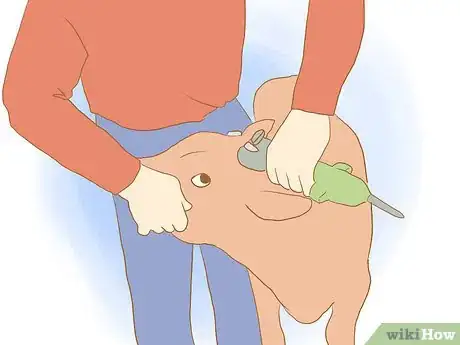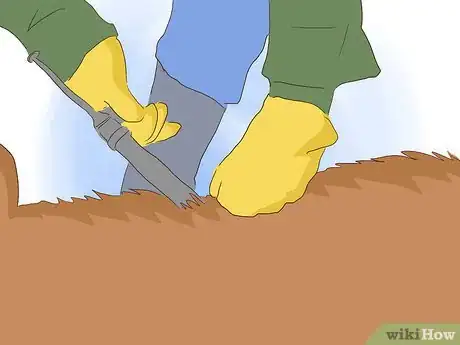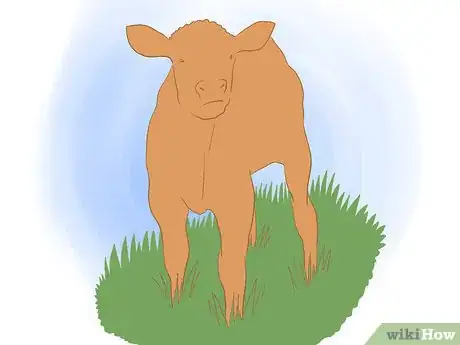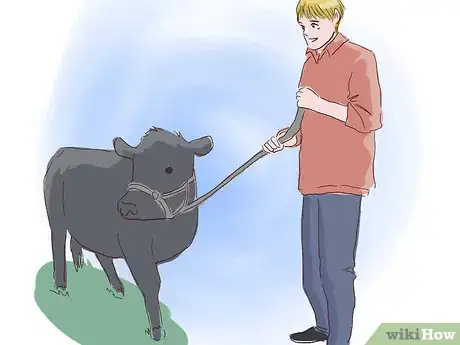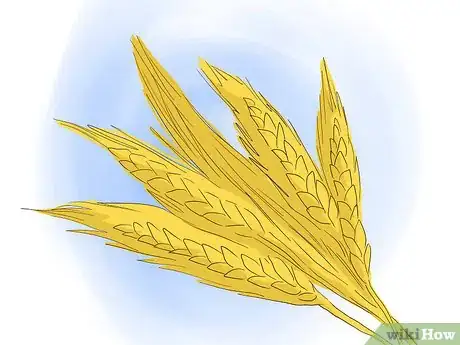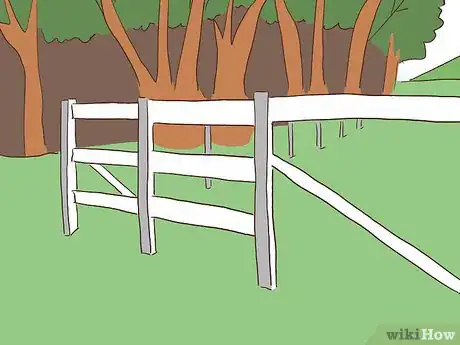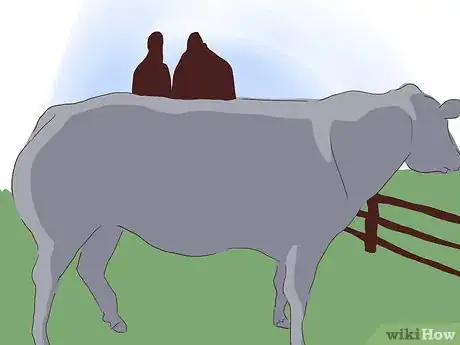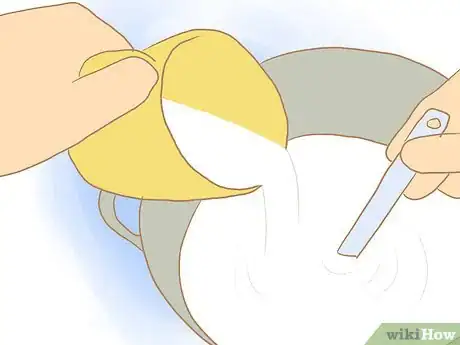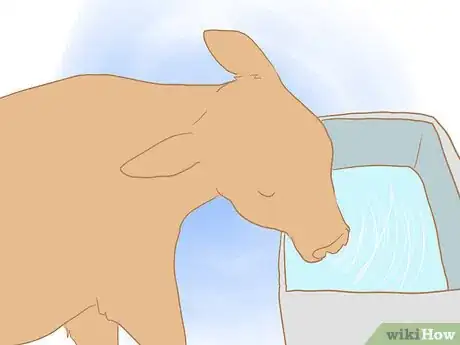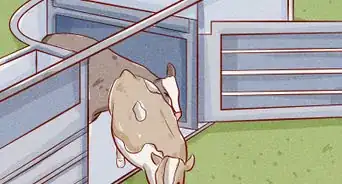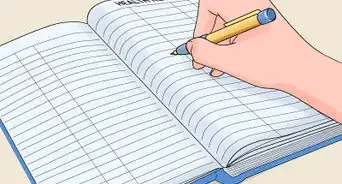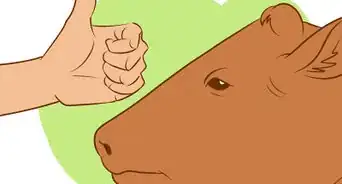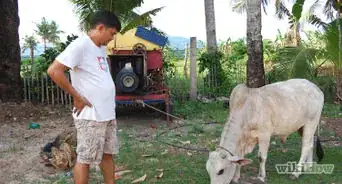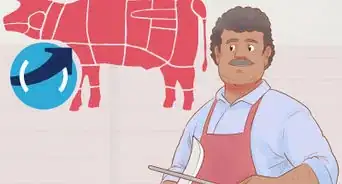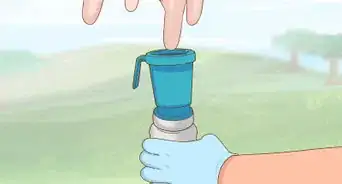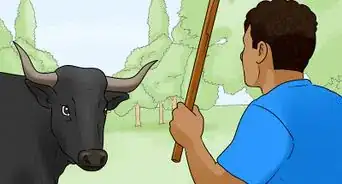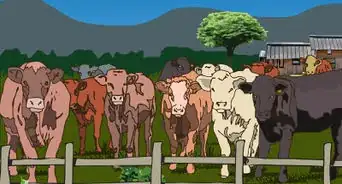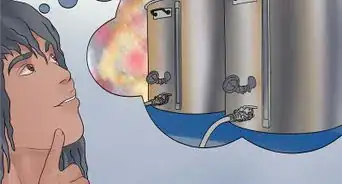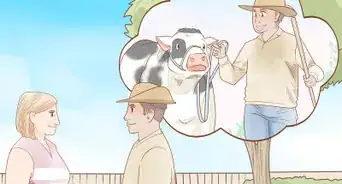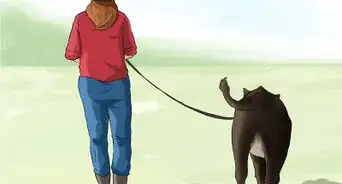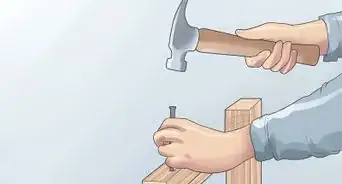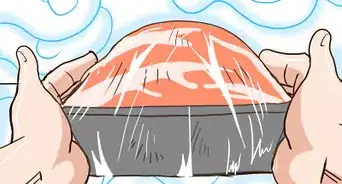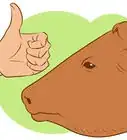This article was co-authored by Karin Lindquist, a trusted member of wikiHow's volunteer community. Karin Lindquist earned a BSc in Agriculture as an Animal Science major from the University of Alberta, Canada. She has over 20 years of experience working with cattle and crops. She's worked for a mixed-practice veterinarian, as a sales representative in a farm supply store, and as a research assistant doing rangeland, soil, and crop research. She currently works as a forage and beef agriculture extension specialist, advising farmers on a variety of issues relating to their cattle and the forages they grow and harvest.
wikiHow marks an article as reader-approved once it receives enough positive feedback. In this case, 88% of readers who voted found the article helpful, earning it our reader-approved status.
This article has been viewed 188,953 times.
Learn more...
Weaning is the practice of separating calves from their source of milk, a stressful time on both cows and calves, as it is very traumatic in an environmental, psychological, and nutritional sense, especially for the calf. This article highlights the general concepts and steps of how to wean calves from cows and vice versa. The article starts with the traditional method of separating cows from calves and sending the calves away where they cannot hear, see nor smell their dams, to weaning using spiked nose rings.
Most calves are weaned between 120 and 290 days (3 to 10 months) after birth, but most producers like to wean their calves when they're around 205 (6 months) of age. Weight is also a factor, with the minimum being generally around 132lb (60kg).[1]
Steps
Preconditioning calves prior to weaning
-
1De-horn and castrate well ahead of weaning time. This will minimize stress on the calves since this will not be done right at weaning time, causing illness and weight loss in the weaned calves.
-
2Bring the cows and calves into a small well-fenced pasture paddock two to three weeks ahead of the actual weaning schedule to get the calves used to their new surroundings. If weaning paddocks are not available, use small pastures (with good fencing!). Don't put the cows and calves in pens that consist primarily of dirt; this is to avoid respiratory diseases and pneumonia caused by dust that often crop up during and after weaning time.Advertisement
-
3Precondition the calves. Creep-feed (or precondition) the calves so that they learn to eat from a feed bunk before being weaned.
- Preconditioning calves is a great method to adopt to reduce stress for calves at weaning time. Preconditioning involves getting calves used to eating out of a feed bunk or trough, and drinking from a water trough. This should be done without the cows around, as cows tend to be more pushy and bossy around the feed bunk and water trough, not allowing the calves in at all. Use of a creep-feeder is best to get the calves used to eating out of a feed bunk.
- A creep feed or precondition ration for calves should include a mix of grain silage (corn, sorghum, barley, wheat or oats) and legume-hay, plus a concentrate supplement that includes protein. Make sure the supplement you are giving them does not have animal by-products in it at all, as this could be serious if one or some of the calves develop symptoms of BSE when they get older (especially in those heifers that will be used as cows.)Also, keep the feed free of mold and dust, as this will cause calves to get sick with illnesses like pneumonia.
- Preconditioning calves is a great method to adopt to reduce stress for calves at weaning time. Preconditioning involves getting calves used to eating out of a feed bunk or trough, and drinking from a water trough. This should be done without the cows around, as cows tend to be more pushy and bossy around the feed bunk and water trough, not allowing the calves in at all. Use of a creep-feeder is best to get the calves used to eating out of a feed bunk.
-
4Provide immunization and boosters. Give calves their first immunization treatments while they're still nursing, and follow with booster shots as recommended by your veterinarian or the manufacturer of the vaccines. A herd-health program should have been established between you and your local large animal veterinarian so that you are prepared to give the calves whatever needs to be given in your area.
- Treat for internal and external parasites as well.
-
5Wean the calves by moving the cows out of the weaning paddocks so that the calves remain in their familiar surroundings.
-
6Keep an eye on the calves during this stressful period. Handle and treat the calves with care and a bit of TLC. Confide with your veterinarian about use of tranquilizers during the weaning process to calm the calves and to minimize weight loss.
-
7For the cows, do not feed milk-stimulating feeds (those that contain high amounts of calcium and proteins) to cows at weaning time. Putting them on a grass-only diet of hay or putting them out on poorer pastures will help the drying up process proceed quicker.
-
8Do not milk the cows during this time. Keep an eye out for any signs of mastitis or swollen udders.
The actual, traditional, low-stress weaning process
-
1Make sure it's a good day to wean. Sunny, calm and warm weather is better than windy, rainy or cold weather.
-
2Put feed out in an area where the cows will be able to see and smell you putting out the feed.
-
3Let the cows out. Once the cows are at the gate, open up the gate and let them through, using calm and effective herding cattle practices. You can choose to let a few cows at a time to ease the calves into the weaning process, letting out a handful of cows out of the weaning paddock into another one once a day or twice a day, however many cows and calves you have to wean.
- You can choose to leave a few babysitter cows–those that are open (not pregnant) and you intend on culling later on, or need better quality pasture because of their age–with the weaned calves. Yearling heifers even work great as den-mothers or babysitters.
-
4Close the gate after the number of cows you wish to let out are out, making sure none of the calves have chose to escape in the meantime. Usually with calm handling practices, you won't get any calves that will escape, because usually the cows go through the gate first, then the calves follow soon after.
-
5Leave the calves in the corral for a few days until they've settled down before you decide to load them up and sell them at the auction mart.
Natural Weaning
- Let nature take its own course. This method doesn't really require any human intervention at all, since the cow will take on the primary responsibility of kicking her calf off. Usually in rangeland or extensive ranch environments where there is minimal management and cattle are not brought home to be weaned, the cow will kick off her last year's calf just before her new baby is born.
- This often isn't the best way to wean calves, as it can be hard on the cow if she needs to gain body condition before she calves, and needs the rest from lactation between calves. Cows milk better and gain weight easier after their calves are weaned a bit earlier.
- However, nature's way of weaning calves from their cows is a lot less stressful than the way it's done with human intervention. The calf is still able to keep in the family group and with the herd, because of the security and sociological advantages the herd has over being being put in an unfamiliar place and expected to, all of a sudden, eat hay and silage and "do well" on his own.
Traditional corral weaning
- Note what happens where calves are separated off the pasture from their dams. If you put them into a corral, give them hay and water and leave them to, essentially, "fend for themselves", they will frantically miss their mothers. Their insecurity, panic, and desperation is contagious: when one calf starts bawling and running up and down the fence line, the others follow suit. Often this occurs after the calves have been separated from their dams, shipped in a trailer to a stockyard where they are put through the auction ring, then hauled to a distant farm where they are set to get used to their surroundings and "settle down a bit."
Fence-line weaning
-
1Prepare. Following the steps above in the sections "Preconditioning Calves Prior to Weaning" and "The Actual Traditional Low-Stress Weaning Process," separate cows from the calves into adjacent paddocks where they can see and possibly sniff each other but the fence does not allow any suckling to occur.
- Placing page wire and strands of electric wire on either side of the fence is a good way to keep from calves and cows from getting back to each other. Having a two-layered fence built may also help prevent the more desperate mothers from getting back to their calves.
-
2Leave them be. Allow this interaction for the next 3 to 5 days, until you see the cows and calves losing interest in each other.
-
3Move the cows after several days. If you wish, you can move the cows to another pasture after this weaning process has gone through.
Nose-flap or spiked nose ring weaning
-
1Run the calves through the crush or squeeze chute.
-
2Put the nose flaps in the calf's nose; you will just need to manipulate the ends of the nose ring so that it will stay in the calf's nose, or use a small screwdriver or wrench to adjust and hold the nose-flap or spiked nose-ring in place. The nose ring is temporary, unlike a bull's nose ring, and will be removed after a week or two.
-
3Let the calf out with the cow. The cow will kick off the calf if he attempts to nurse because the spikes on the nose ring prod her in the udder. The nose ring does not prohibit the calf from grazing, eating in the creep feeder or drinking water, nor does it prohibit the calf from being with his mother.
-
4After a week or two has passed, the cow's milk will have started to dry up and the calf will have already adjusted to not having milk. You can now separate the cows from the calves with very little stress and remove the nose rings from the calves. Ideally it is best to remove the weaner rings after seven to ten days.
Weaning hand-reared calves
-
1Prepare yourself for the weaning process. Weaning an orphan calf that you have raised and nurtured for the past few months can be and emotional strain on both you and the calf. The calf will complain a fair bit during the weaning process but you must be diligent and stubborn.
- Bottle calves should be weaned by the time they are around 3 to 4 months of age.
-
2Consider two ways of weaning the bottle calf. These two methods include reducing the quantity of milk the calf gets per day, or diluting the milk solution gradually to the point where he's drinking only water.
- Reducing the quantity of milk can be a bit more stressful on the calf because he'd not getting the same amount of milk that he had before the weaning process started. Cutting back a few pounds per day is a good way to start.
- Diluting the milk is more towards the natural way a cow would wean her calf. This is because by the time the calf has reached a certain age (i.e., 3 months), the milk quality that the cow produces decreases over time. Diluting the milk formula an eighth (1/8) at a time until the "milk" is 100% water is a good way to go.
-
3Provide feed, water and mineral at all times during the weaning process. The calf should already be eating hay and/or grain and/or grass by the time the weaning process has started.
- Also ensure that the hand-reared calf is on good pasture that is clean and leafy, if there is pasture available.[2]
Community Q&A
-
QuestionWhy does a bottle calf need to be weaned at three to four months of age?
 Community AnswerIt's not that the calf needs to be weaned at this age, it's that the calf has its rumen fully developed enough to be on full-feed and much less to no milk. A calf this age gets pretty big and boisterous to be continued to be raised on the bottle, which is the other reason why they get weaned off the bottle then. Calves on their dams don't get weaned until they're 6, 8, or even 10 months old, and its because their dams can handle them and their seemingly aggressive craving for milk because their dams are ten-times bigger and more solid than a human!
Community AnswerIt's not that the calf needs to be weaned at this age, it's that the calf has its rumen fully developed enough to be on full-feed and much less to no milk. A calf this age gets pretty big and boisterous to be continued to be raised on the bottle, which is the other reason why they get weaned off the bottle then. Calves on their dams don't get weaned until they're 6, 8, or even 10 months old, and its because their dams can handle them and their seemingly aggressive craving for milk because their dams are ten-times bigger and more solid than a human! -
QuestionHow much milk does a cow produce per day? For how many months does a cow produce milk?
 KarinTop AnswererThe amount of milk depends on the breed and type of cow. Beef cows will produce around 10 to 20 pounds of milk per day, while dairy cows will produce 70 to over 80 pounds of milk a day. Dairy cows will produce milk for 10 months, while beef cows will be lactating and suckling a calf for 6 to 8 months.
KarinTop AnswererThe amount of milk depends on the breed and type of cow. Beef cows will produce around 10 to 20 pounds of milk per day, while dairy cows will produce 70 to over 80 pounds of milk a day. Dairy cows will produce milk for 10 months, while beef cows will be lactating and suckling a calf for 6 to 8 months. -
QuestionHow long does it take the average calf to be weaned?
 Community AnswerYou should leave the calves and cows separate for at least 6 to 8 weeks. This gives the calves time to adjust to being away from their moms and not suckling.
Community AnswerYou should leave the calves and cows separate for at least 6 to 8 weeks. This gives the calves time to adjust to being away from their moms and not suckling.
Warnings
- Putting feed out first before you let the cows out will both enable you enough time to get the gates closed before the calves decide to come out too, and also avoid getting run over by a bunch of big greedy cows.⧼thumbs_response⧽
- Don't yell at or chase the cattle. This will only add to the stress of the calves during weaning time.⧼thumbs_response⧽
- Beware of the likely reaction of the first-calf heifers. They will crawl the fence if you do not make it escape proof with a couple of strands of hot electric wire or steel panels. First-calvers are often so determined to keep their first born forever that they will do literally anything they can to get him back. You cannot let this happen.⧼thumbs_response⧽
References
- ↑ Trisha Fisk, Practical Smallfarming in New Zealand, p.120, (2009), ISBN 978-0-14-301089-0
- ↑ Trisha Fisk, Practical Small Farming in New Zealand, p.120, (2009), ISBN 978-0-14-301089-0
- Ensminger, M.E. & Perry, R.C.. Chapter 21 Feeding and Handling Calves. Beef Cattle Science. 7th edition. Interstate Publishers Inc.: Danville IL, 1997; p 727, ISBN 0-8134-3006-2 – research source.
- Thomas, H.S. Chapter 13 Weaning Calves. Storey's Guide to Raising Beef Cattle. 2nd ed. Storey Publishing: US, 2009; pp 270-276, ISBN 978-1-60342-454-7 – research source.
